The Building
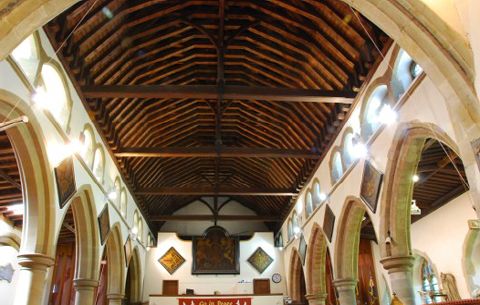
The Nave
The main body of church buildings is called The Nave, which comes from the Latin word 'navis', meaning 'ship'. If you look up at the roof you will see that it looks like the bottom of a boat. Church buildings are symbolic and this particular part of the church reminds us that this is a place where people pass through life to the safe harbour of heaven.
One of the ways churches serve their communities is in guiding them through the 'rites of passage' that mark the stages of life. We remember and celebrate the birth of new life with baptism and thanksgiving services.
Adults as well as babies are baptised, because in baptism we celebrate our new life in Jesus Christ, who restores and heals us when we commit to follow him. You can read about Jesus Christ's own baptism in the Bible.
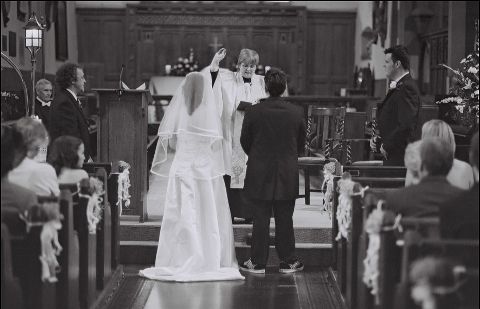
A Church Wedding.
We also celebrate marriage, and support people in the death of loved ones through funerals and memorial services. Such passages of life can be seen in our Parish registers, which record the people of Tonbridge through the centuries, their births, marriages and deaths. Through these registers we know the names as well as the numbers of plague victims, cholera sufferers and Civil War casualties, and know that their families were supported by the church.
For many people, these significant and emotional rites of passage (often referred to as 'hatch, match and dis-patch'!) are their only experience of church, and in this way the analogy of a ship is a good one
The Chancel
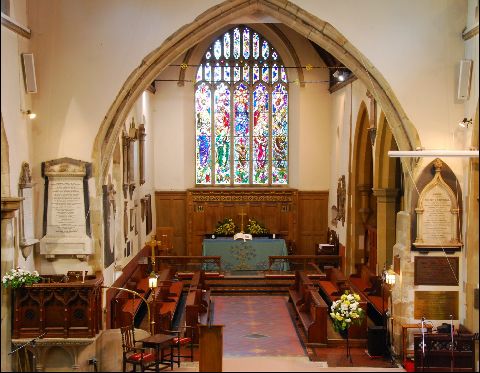
At the end of the Nave is the oldest part of our church and its very heart. It is believed that this part of the church is where the original Saxon building was; the north wall of the chancel still has Saxon brickwork, which can be seen from the churchyard. It was certainly where the first Norman structure was – you can still see the tracing of a Norman window in the vestry.
The Table is where we meet with Jesus Christ in communion, symbolically remembering his last supper before his crucifixion, where he took bread and wine and gave it to his disciples saying 'this bread is my body, broken for you; this wine is my blood, shed for you. Do this in remembrance of me.'
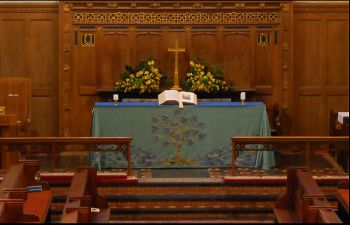
The Table where we celebrate Holy Communion.
During Holy Communion we remember Jesus Christ's sacrifice and his promise that through it our relationship with God would be restored. Then we can pray as Jesus taught us: 'Give us this day our daily bread' that we may be spiritually fed and nourished, that we may depend on God as our bodies depend on food and drink.
The cloth covering the table was designed and made by Angela Dewar and represents the Tree of Life from the last book of the Bible, Revelation, which gives a picture of heaven where 'the leaves of the tree are for the healing of the nations' (22:2). The kneelers were stitched by members of our Tapestry group and depict the 'I AM' sayings of John's Gospel, which are metaphorical sayings Jesus Christ used to help us understand who he was.
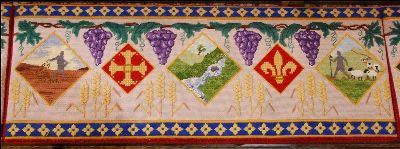
One of the kneelers on the sanctuary steps which depicts the parable of the sower, (Matthew, Mark and Luke), Jesus as Living Water (John 4) and 'I Am the Good Shepherd' John 10. Running along the top are grape vines which depict the saying 'I am the vine, you are the branches'(John 15).
Memorials in the Chancel
Sir Anthony Denton
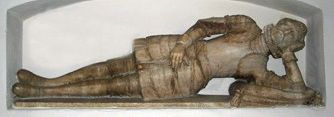
Sir Anthony Denton. Above his effigy is his funeral helmet, a mark of his Knighthood.
To the right of the Table you will see two effigies. These are Sir Anthony Denton and 'his deer and dolefull wife' Elizabeth. Such memorials are normally seen in Cathedrals, but Sir Anthony Denton was the lay rector of our parish until his death in 1615. This meant he was a nobleman who inherited the legal right to appoint the vicar of this parish and possession of 'all lands, tithes and the like in Tunbridge Warde', a right he inherited from his father.
He had a residence in Tonbridge as well as two in London. The inscription by his tomb names Sir Anthony as "one of the Honorable band of Pensioners (both to our late, renounced Lady Q Elizabeth, & also to our now sovereign Lord K James)". The Gentleman Pensioners were an elite group of fifty knights, established by Henry VIII as royal bodyguards. Account rolls from the time tell us Sir Anthony served in this position from 1602 until 1615, and this may account for his prominent burial in the church; above him is his funeral helmet, the mark of a Knight.
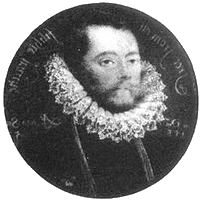
A portrait of George Carey, the 2nd Lord Hunsden who recruited Sir Anthony to the Royal body-guard.
It may also be this connection with court which led to a playhouse being established in Tonbridge. Indeed, all we know about it is that "Sir Anthony Denton's man", Edward Caverly, was 'fatally wounded' in a brawl at the 'Tunbridge Playhouse' in 1610. His attackers were tried at Maidstone Assizes court, and it is from those records that we know of the Playhouse, which was one of only four others known outside London at this time. The date of the brawl is that of the Midsummer fair, when visiting players may have been part of the festivities.
While Sir Anthony may have supported the play-house, it is more likely that another nobleman was behind its building. Sir Anthony was recruited to the Pensioners by George Carey, the 2nd Lord Hunsdon, who then owned Tonbridge Castle and as Lord Chamberlain, was patron to the Lord Chamber-lain's Men, the playing company that included William Shakespeare. Could these have been the players who came to the Midsummer Fair? They are recorded as performing at Maidstone and Canterbury at this time, although by now called The King's Men. James Burbage was involved in another playhouse fray, where he named himself as 'Lord Hunsdon's man.'
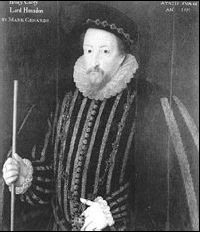
A portrait of Henry Carey, the 1st Lord Hunsden, and probably son of Henry VIII.
The first Lord Hunsdon, Henry Carey, was the son of Mary Boleyn – 'The Other Boleyn Girl’, and was awarded 'the manors of Tunbridge and Hadlowe, the castle of Tunbridge' and extensive parks by his cousin, Elizabeth I. She later granted permission for the three annual fairs, including the Midsummer one on June 25th, which provided an opportunity for the Lord's players to perform. June 25th is the date given for the brawl where “Sir Anthoy Denton's Man” was injured.
These powerful friends may explain Sir Anthony's prominent burial by the Holy Table, although there is no evidence of him particularly benefitting the church. His untimely death, at 54 years old, may be another reason for his prominent memorial. His wife remarried and eventually passed the rights to her son.
Memorials to the famous and fondly remembered are no longer displayed in churches, which prefer to focus on Jesus Christ, the living members of their congregations and communities. But there is some-thing restful about these figures, lying in wait of the Resurrection and the return of their Lord.
Side by Side, their faces blurred,
The earl and countess lie in stone,
Their proper habits vaguely shown
As jointed armour, stiffened pleat,
From An Arundel Tomb.
By Philip Larkin. The Whitsun Weddings Faber and Faber 1964.
Henry Harpur
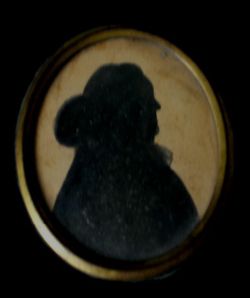
A silhouette of Rev’d Henry Harpur, JMW Turner’s uncle, and the Vicar who oversaw George Austen’s first curacy.
To the left of the Table you will find a memorial to Henry Harpur. He was vicar from 1756 to 1791 and so oversaw George Austen's (father of the novelist Jane Austen) curacy at Shipbourne, which was then within our parish. At one point this was the Austens' Parish Church and you can find out more about their Tonbridge connections in a separate guidebook.
Henry Harpur was also JMW Turner's uncle. Turner reportedly stayed here during his summer holidays, and on one such occasion painted a scene of Tonbridge Castle, which is now in the Fitzwilliam Museum in Cambridge.
There are many other notable memorials you can find in the church – there is one to cricketers Colin Blythe and Frank Woolley and of course the war memorials, which remain a focal point of our annual service of remembrance. Each year we also hold a service of quiet reflection and thanksgiving to help those who have been recently bereaved.
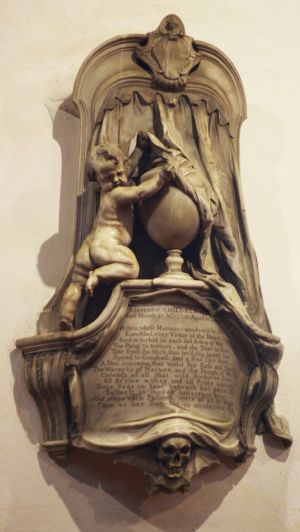
A memorial to Richard Children which is of interest as it was designed by Roubillac, an 18th Century French sculptor who was also commissioned to do monuments in memory of Handel, George I, Sir Isaac Newton and Shakespeare.
Mass Dial and Clock
To the right of the Table is the vestry where you will find the remains of a circular incision carved into the door post. This is a medieval mass dial and was the sole means of calling people to mass before the Reformation.
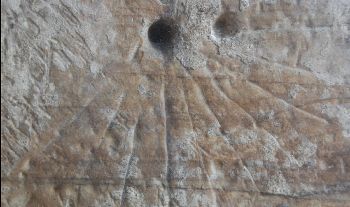
Medieval mass dial
It was not until the 17th Century that most churches were given clocks. These were time-pieces for the town as few people had watches. Our present clock dates from the 1870s and its striking helps us remember that our times are in God’s hands. (Psalm 31:15).
The Organ
The organ you see today was completed in 1953 and rebuilt in 1985. The original organ was built in 1788, and then stood at the west end of the church, where the present gallery is. The repositioning brought the organ to join the choir and also meant the organ 'spoke to' the congregation.
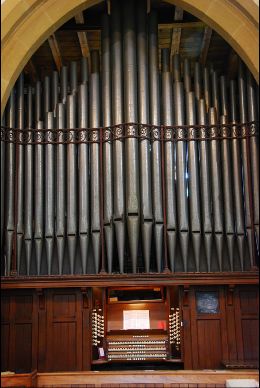
The organ
The organ is still used on occasion for our praise and worship and in front of the pipes you will see the stage area for our other musicians. Our church has a strong tradition of worship; one former vicar was Michael Perry, who wrote many well-known hymns such as The Calypso Carol and O God Beyond All Praising.
Like many aspects of our building and our use of it, in worship we need to find a balance between the time-honoured truths of traditional and fresh expressions of faith. Through music we find a new way to express our love for God and affirm ourselves in His promises. But it is never just about singing; in our worship we are reminded how great and good our God is and that he calls us to Him and to service.
The Pulpit
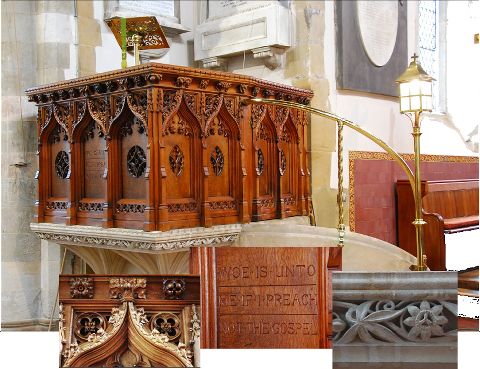
The original pulpit in our church was made by George Wise, who was famous for making Tunbridge Ware. Tunbridge Ware was very popular with tourists in the 1700s and you can see an example of this craftsmanship on display in the foyer. The present pulpit was gifted to the church by Mrs Deacon in 1878. If you look closely you can see the heads of many different animals carved into it. The limestone base has a passion flower surround.
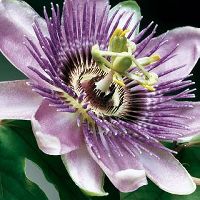
Passion flower
The symbolism of the passion flower was first perceived by a Mexican Augustinian Friar, in 1610, and became a popular way of representing the Easter story, of the passion of Christ.
-
The pointed tips of the leaves were taken to represent the lance that pierced Christ's side.
-
The tendrils represent the whips used by the Roman soldiers who punished Christ with 39 lashes.
-
The ten petals and sepals represent the ten faithful apostles (discounting Peter who denied Christ and Judas Iscariot who betrayed him).
-
The flower's radial filaments represent the Crown of Thorns.
-
The style represents the sponge used to moisten Christ's lips.
-
The 3 stigmata represent the 3 nails that held him to the cross and the 5 anthers below them the 5 wounds (four by the nails and one by the lance).
The inscription on the pulpit comes from St Paul's first letter to the Corinthian Church. In chapter 9 verse 16 he writes "Yet when I preach the gospel, I cannot boast, for I am compelled to preach. Woe to me if I do not preach the gospel"; which is a worthwhile thing for those standing in the pulpit to remember. The Gospel is the proclamation of that Good News expressed in John 3:16 – "God so loved the world that He sent His one and only Son, that whoever believes in Him, shall not perish but have eternal life."
The Lectern
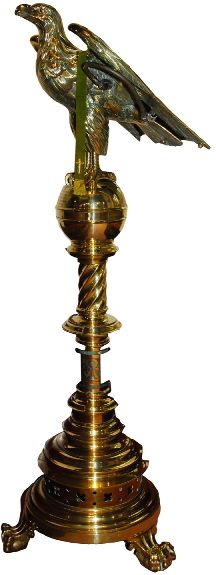 |
We usually use a simple wooden lectern during services, but you will also find a more traditional brass eagle lectern in the chapel of St Nicholas. A Bible is always open on the lectern. It is shaped like an Eagle to symbolise John the Evangelist, author of the Gospel of John, who was traditionally depicted as an eagle.
It is his Gospel that begins with the words: ‘In the beginning was the Word, and the Word was God. Through him all things were made’ (1:1). This calls to mind the creation account in Genesis, where life comes from the word of God. But John also writes ‘The Word became flesh and made his dwelling among us’ (1:14), reminding us that the same God is revealed in Jesus and the words he spoke.
This Lectern was donated to the church in 1892 and is dedicated to Lucy Warner. You can find a memo-rial plaque to her on the north wall where she is remembered as a teacher of the men’s Bible class. It must have taken a lot of courage as a Victorian woman, to teach a class of men about the Bible.
‘Sunday School’ (aka Sunday Club and SOS) continues in our church today, where the children and young people of our congregation still gather to look at the word of God. Adults gather in home-groups to study the Bible and in this way the spirit of Lucy's Bible Class still lives on.
|
The Green Man or Silent Watcher
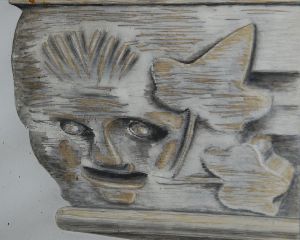
The Green Man or Silent Watcher
In the corner of the roof of St Nicholas Chapel is a rough carving of a Green Man. You may need a torch to see it, but a photo is displayed in the remains of the piscina. This distorted face with ivy leaves coming from the mouth is a common feature of medieval churches although its meaning is still disputed. Some interpret it as a pagan symbol drawn from Greek theatre and believe that the carving was a way of hedging bets between deities. But the symbol is too consistent a feature of churches even beyond the Reformation for this to be likely. The combination of the distorted face and the new foliage makes it more likely that it symbolised mortality and resurrection – the distortion of death and new life coming from it.
Today we are more likely to understand a green man in ecological terms, as one who cares for the planet. Whatever its origin, this little part of our building is affectionately known as ‘The Silent Watcher.’ He looks down on the chapel of St Nicholas, which is now used for prayer, and reminds us that God is not silent or watching from a distance, but is intimately concerned and involved in our lives.